Former Standout Now Coaching from the Sidelines
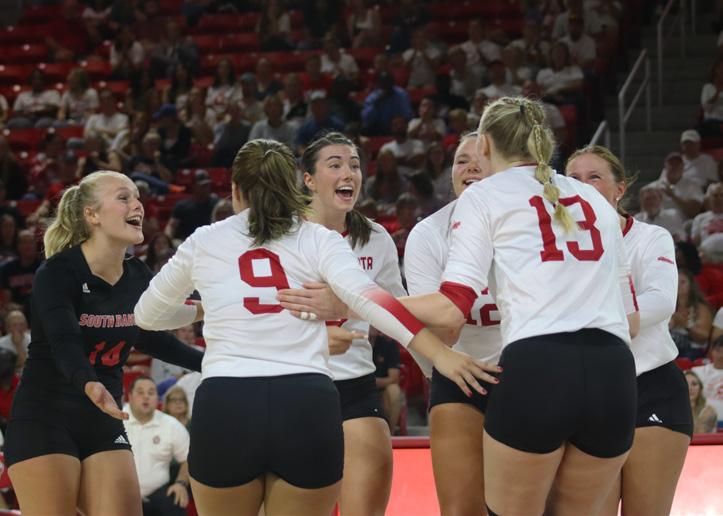
See more on Page 6
National Music Museum Opens it Doors Once Again
See more on Page 11

Former Standout Now Coaching from the Sidelines

See more on Page 6
National Music Museum Opens it Doors Once Again
See more on Page 11

Following last years problamatic housing situation which landed students in lounges, kitchens and study spaces as temperary dorm rooms, this years students did not face the same issues. See more on Page 2
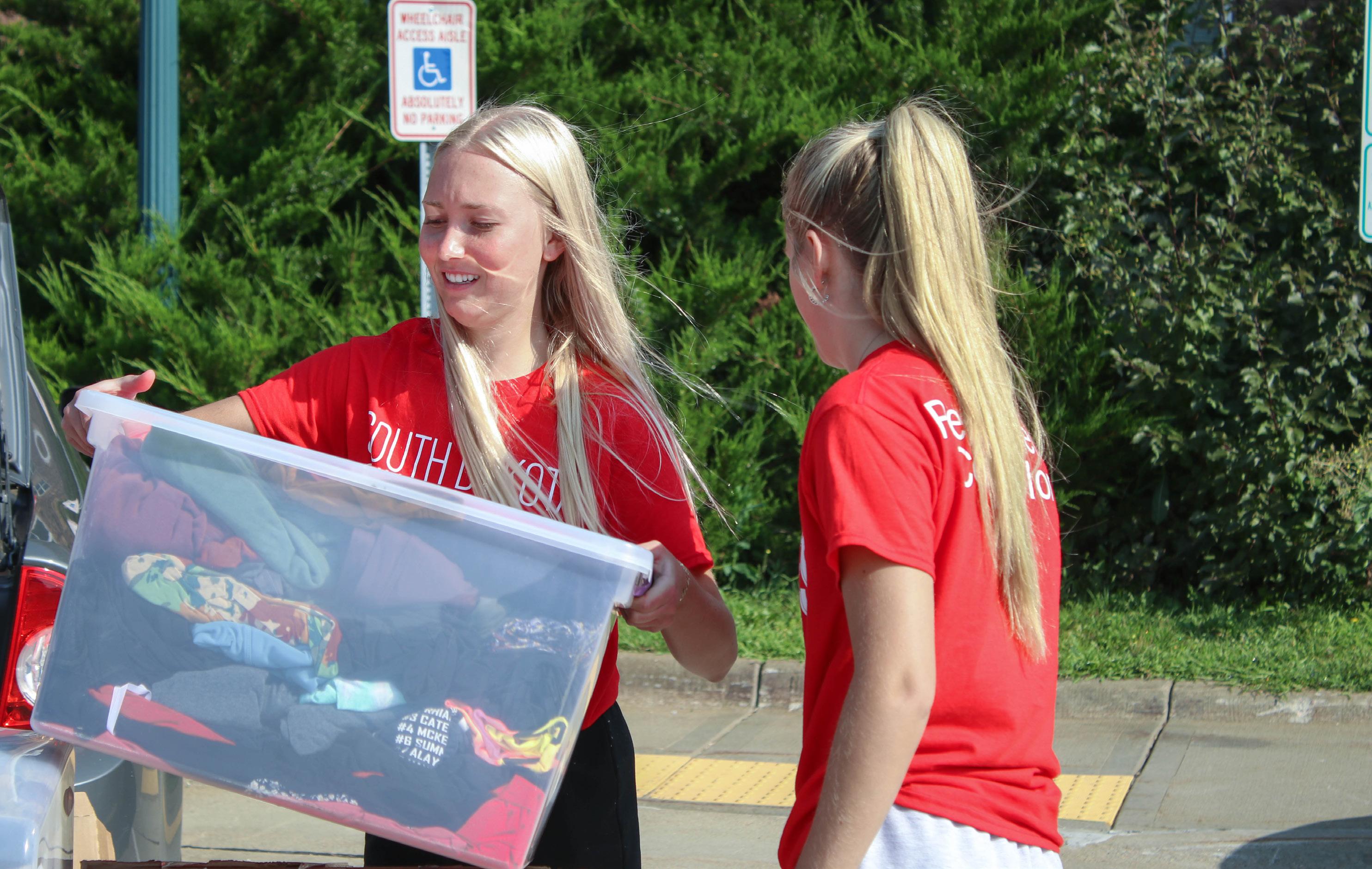
As students made their way back to Vermillion this year, University Housing felt a wave of relief. Unlike last year, they knew they would be able to accommodate all those moving into on-campus housing, and a repeat of last year’s housing conflict was off the table.
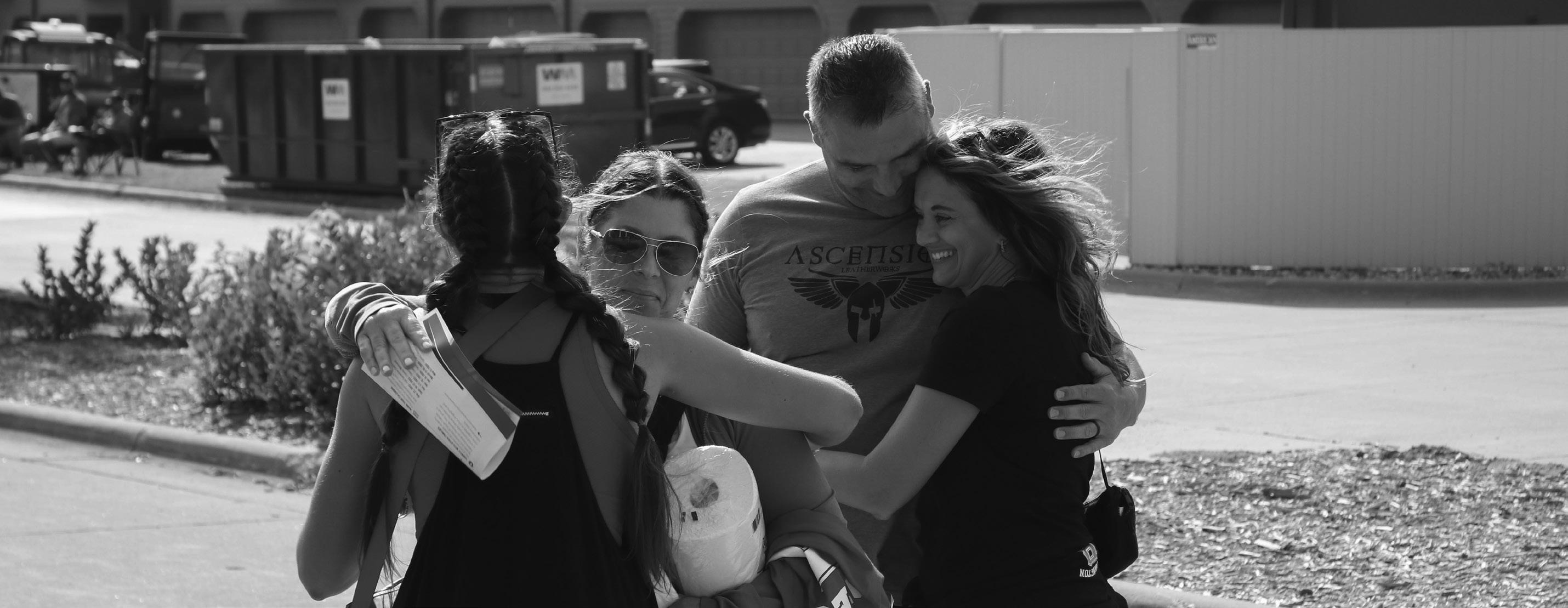
At this time last year, the University was unprepared to house both the incoming and returning students that needed to live on-campus to fulfill the South Dakota Board of Regents (SDBOR) Policy.
Some students began their year living in lounges, kitchens and study rooms in the residential halls until rooms opened up. These improvised living situations were in-part due to a shortage of dorm rooms caused by the renovations taking place in North Complex.
These renovations were completed over the summer, allowing move-in day to run smoothly this year. Director of University Housing Cody
Burgraff said that USD has more available rooms for students this year than they did at the start of the last school year.
“Last year, we had two full floors that were unable to be used due to renovations. This year, all floors are available, which means we have 140 more beds available,” Burgraff said. “Our focus is accommodating all students who require oncampus housing under SDBOR Policy 3:6.”
The SDBOR Policy 3:6 states that students who are enrolled in a minimum of six on-campus credits are required to live on-campus during their first two years following highschool graduation. There are exceptions included in this policy, including if the student is married, has dependent children, lives with their parents, lives in Greek housing, are non-degree seeking or if the residence halls exceed a manageable occupancy.
With this requirement in place, Burgraff said that roughly 1,000 first-year students moved into the dorms this year.
While University Housing’s main responsibility is to accommodate those students who are living
on-campus, Burgraff said that they are still trying to aid the off-campus residents by having conversations with the community.
“As our institution grows, USD will need to be creative in how we serve our students’ housing needs, both on- and off-campus. We have started conversations with the Vermillion community as well as private developers to review all the options available,” Burgraff said. “We will also need to work in conjunction with the SDBOR and other stakeholders to make the best decision that sets our institution up for success.”
According to Burgraff, no current problems are affecting the main University Housing operations. He is aware that each day, any issue can pop up, but he is confident that the team he has will be able to handle whatever may arise.
“There are always day-to-day things to address when managing the amount of people and square footage we do, but with our partnerships between different entities across campus such as Facilities Management and ITS, there is nothing we cannot tackle,” Burgraff said.
USD’s Coyote Career Kickstart has implemented a new service for students from rural communities, thanks to a three-year, one million dollar grant from the US Department of Education.
Launched three years ago, the Coyote Career Kickstart program aimed to support USD students with work experiences. Initially, the program focused on USD students who were first generation college students or Pell Grant recipients.
However, in recent years, the Kickstart has adapted to involve students who graduated from rural high schools - designated as such by the National Center for Education Statistics.
Coyote Career Kickstart’s current main goal is to experiment campus wide and bring in more applicants within the new year. Ongoing efforts include workshops and peer mentoring.
Carol Voss-Ward, the Coyote Career Kickstar’s coordinator, said their goal is to experiment with different ways to help these students.
She stated, “Right now we’re trying some different things, and we’ll see how they go and tweak them. Since it’s a pilot program it’s kind of our mission… Our recruiter is going to be working with the community, some rural communities to help develop some career ready opportunities for students.”
The Academic and Career Planning Center and other offices across campus offer similar career services, but Voss-Ward said there was a strong desire to extend services to all students.
“We got this federal funding… to do things to help students in rural communities and broaden horizons, so we can offer more things across campus… like money or opportunities to try other things that [members] wouldn’t have tried otherwise,” Voss-Ward said. “It would be super helpful if we have a bigger broader network of internships for all students instead of students in one particular major or college.”
In previous years, the Coyote Career Kickstart balanced between 25 to 30 students. This year, they are supporting 73 freshman students in the Coyote Career Kickstart First-Year Experience and peer-mentoring
program. Additionally, nine students have been paired with USD alumni mentors, while six kickstart students are serving as peer mentors themselves.
Voss-Ward assured that students who already joined Kickstart will still receive services. “We are continuing to offer services that were promised to the first two cohorts of Kickstart participants” Voss-Ward said.
These include being paired with an alumni mentor as well as being able to take courses focused on career readiness and financial literacy. Prospective students can submit applications to join the Coyote Career Kickstart. Currently, applicants to the Coyote Career Kickstart can take career related courses and workshops and help internships for the summer.
For further information, visit to Coyote Career Kickstart’s web page at https://www.usd. edu/Admissions-and-Aid/Financial-Aid/WorkOpportunities-for-Students/Coyote-Career-Kickstart or reach out to them via email at kickstart@usd.edu.
In a community where violent crime is scarce, a recent homicide has garnered attention. Chief of Police Crystal Brady noted that these types of crimes are rare, with student-crimes being much more prevalent. Furthermore, Brady anticipates continuing to crack-down on student-crimes this year.
“It’s a fairly safe community when it comes to that type of violent crime,” Brady said. “We also had a homicide that happened a couple weeks ago, pretty rare for our community. We had a baby that was murdered a few years ago by the parents, but other than that, we haven’t had a homicide here since 2002.”
According to a July 30 press release from the Vermillion Police Department, they responded to a 911 call regarding a stabbing, in which the victim later died. Twenty-year-old Chezayla Liggins of Omaha, Nebraska was later arrested and charged.
While student crimes like underage alcohol, fights and sexual assault decreased over the summer, Brady anticipates an uptick in the coming months.
“Normally, September and October are the busiest time for sexual assaults, and I think it’s because oftentimes, the freshman and sophomores are involved in these,” Brady said. “They go out and start drinking and think they can consume quite a bit of alcohol. They don’t think it’s affecting them, and all of a sudden it’s affecting them quite a bit.”
Brady said the department’s main approach to deterring these types of crime
involves proactive planning for large events and raising awareness of the ordinances.
“There’s so much planning ahead of time to make sure that the groups have things in place to make sure people are being identified,” Brady said. “We go out and do talks with incoming freshmen, letting them know what the alcohol ordinances are. We go downtown and do foot patrol on weekends.”
Despite the department’s attempts at educating the college students, many remain unaware of the serious consequences of using a fake ID.
“You do end up going to jail for this [false impersonation]; it is a class 1 misdemeanor… you do get arrested, and you do go to jail,” said Brady. “When people go downtown and use them, it leads to other things. It leads to binge drinking downtown, which can lead to property damage when walking home. It leads to sexual assault because they drink to the point where they don’t remember what’s happening and they’re left vulnerable… We really are trying to deter all of those things from happening.”
Students who disregard Brady’s warning can expect the same outcome as last year: a ticket.
“If they have to learn a lesson by getting a ticket, then that’s the way that it has to be,” Brady said. “We’re going to continue to do our job, and we’re going to do the exact same thing this year as we did last year.”
To learn more about the Vermillion Police Department and the city ordinances, visit https://vermillionpd.org/.
On Aug. 24, GatheRED celebrated its third year on the Platz. The event serves as the conclusion to the summer-long series Thursdays on the Platz, in which live music was played every Thursday on the Ratingen Platz in Vermillion.
The Vermillion Area Chamber and Development Company (VCDC) hosts Thursdays on the Platz beginning after July 4 and continuing until the final week of August. The final Thursday is sponsored by USD, so the event was renamed to GatheRED three years ago to better promote the event to students.

The event typically consists of a variety of vendors and live music. This year, Hy-Vee, Karli’s Kitchen, Pizza Ranch, Cow & Spoon, Sweet Treats and Sodexo were all in attendance, with Fernson Brewing Company serving beer. A limited number of vouchers were available for students to receive a free meal.

Sophomore Zena Aragon attended her first GatheRED last year when she performed with the dance team. Aragon said the best part was getting to see the community come together.
“I think it’s a great way for new incoming students to reach out to public members or community members, and I feel like it’s a great way to actually see downtown. [It was] the first time I got to come down and see all the shops and see actual vendors and I feel like it made it [Vermillion] feel like a home and not just
place I go to college,” Aragon said.
This year, the band Blue Rune and the Sound of USD performed. President and CEO of the VCDC Jim Peterson sent a statement to The Volante and said USD is a great partner because the VCDC wants students to better know Vermillion and the community.
“GatheRED is great for Vermillion because it gives students the opportunity to get engaged in the community right after they move in. It gets them off campus and into downtown, they get to see a local band, try some local food and see and meet local businesses,” Peterson said.
Katey Ulrich, Director of Admissions and Marketing at the Knutson School of Law, has been a volunteer for Thursdays on the Platz for seven years. Ulrich said Fernson Brewing Company showcased the Yipeeo! beer and student organizations were able to table off campus. Previous years have seen tremendous growth, and Ulrich said the event continues to grow as more students become interested.
“I hope that it grows. It’s grown a lot in my seven years of volunteering,” Ulrich said. “So, I hope it continues to grow in both numbers of people attending but also just numbers of organizations participating and opportunities for community businesses to be involved in it, too.”
While GatheRED won’t return again until next year, students and community members can learn more about the different events that the VCDC hosts on their website, livevermillion.com.
The Vermillion High School’s (VHS) Gender & Sexuality Alliance (GSA) and the Mural on the Wall teamed up to create the new mural in downtown Vermillion on the west-side of Café Brulé.
Lead artists on the project were Amber Hansen, USD assistant art professor, and Reyna Hernandez, the senior secretary in the USD English Department.
Mural On The Wall is a community-based mural team from Vermillion and was founded in 2019. The team has facilitated several mural projects in various communities, beginning with the two-part mural at the Coyote Twin Theatre.
The GSA received a grant from the It Gets Better Project, an organization dedicated to uplifting, empowering and connecting LGBTQ+ youth around the globe by funding projects that align with their mission to uplift, empower and connect LGBTQ+ youth around the globe.
One school in each state is awarded a grant. VHS was one of these recipients. Weekly meetings started in the fall of 2022 with the GSA students and the Mural on the Wall artists.
“Our design team with the GSA consisted of 10
to 15 people. Many more people came out to help us paint. We had over 40 people painting with us on our community painting day and nearly 70 people who contributed throughout the painting process,” Hansen said.
The mural gained a lot of community support and had many contributors to the painting process, Hansen said.
“We both served as lead artist on this project and were assisted by Kayli Stiles, Marie McLaughlin and Darcy Millette during the painting portion, along with many individuals from the community who came to help paint. The star quilt was designed by Clair Packard,” Hansen said. “Sonia Packard manages our social sites and media. Nina Jordre is the GSA president and the project organizer.”
Stories in communities directly impact the art created, especially communal art such as a mural, Hansen said. There is an art to storytelling and an art to the creation of an entire mural.

“Humans have been decorating the walls for thousands of years with images that are meaningful to them,” Hansen said. “They are a reminder that we have power and agency to write and tell the stories that are important to us and that we can also share those
stories with others for everyone to enjoy.”
Art provides agency and the power allowing individuals to tell stories, Hansen said. Murals provide a sense of support for other forms of content in our environment like advertisements on billboards don’t.
“Murals offer a space for us to fill our visual environment with images that are meaningful to our lives and our experiences living in this place,” Hansen said. “They are a counter narrative to advertisements that target the insecurities that exist within our identities and our understanding of who we are and messages that are constantly telling us that we are not enough and are needing something.”
There’s much meaning to be derived from all of the murals in Vermillion. Recognition of the GSA students and the identities of people within the LGBTQ+ community is vital, Hernandez said.
“We hope that people will spend time looking at the imagery, asking questions about its meaning and assigning meaning of their own to the imagery. Additionally, we hope that the artwork will remind people of the highschool students who led this project and the importance of Two-Spirit People and the LGBTQIA in our community.”
On Dec. 2, in the first round of the 2022 NCAA Volleyball National Tournament, the South Dakota Coyotes faced off against the No. 23 Houston Cougars. The Coyotes trailied 2-1 in sets and 15-11 in set four, with their season on the line.
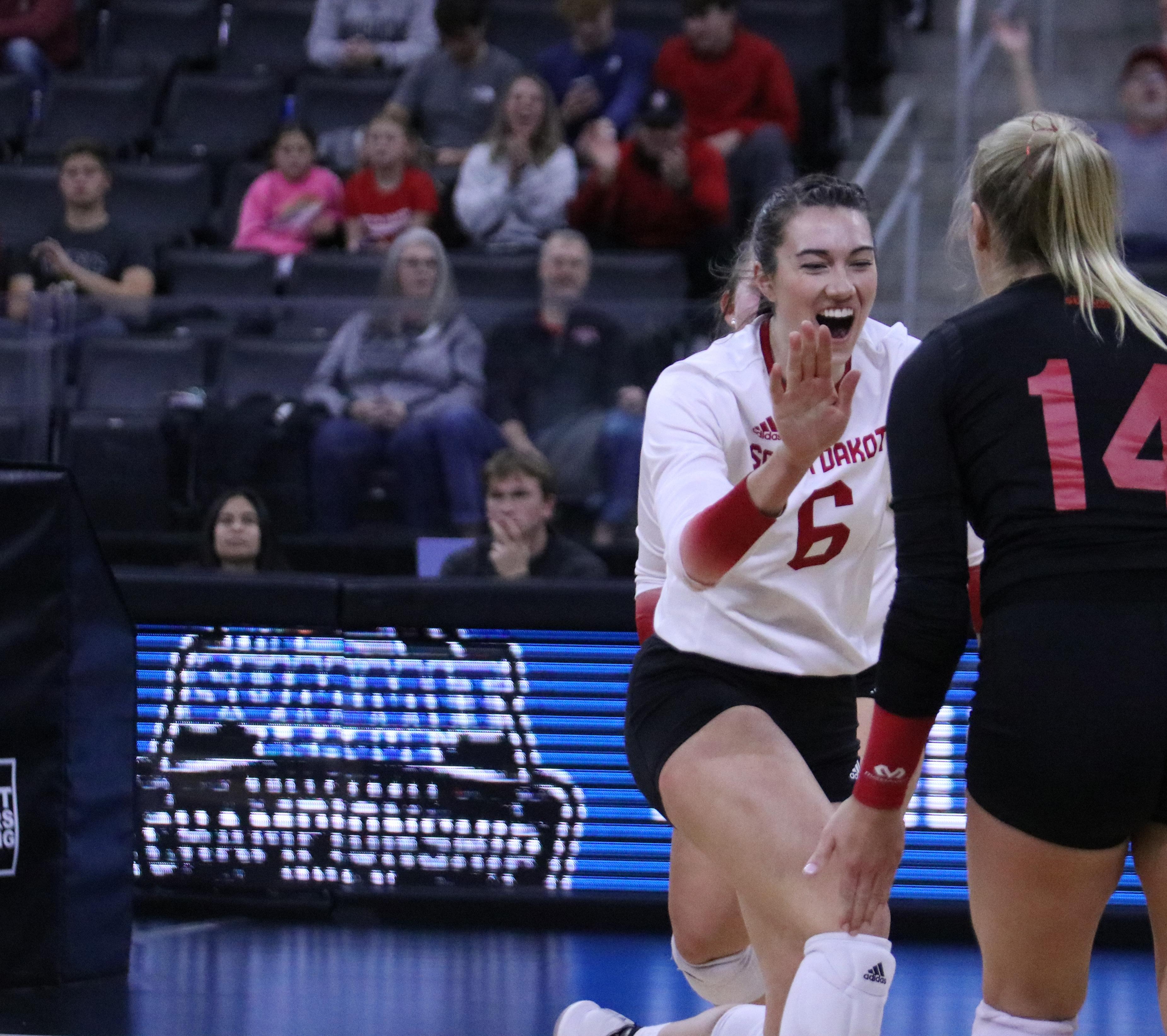
With back-to-back kills, Elizabeth Juhnke attempted to lead the Coyotes to set five for a chance at victory. Unfortunately, she landed awkwardly on her leg and had to be taken out of the game.
The Coyotes managed to rally to win set four 25-23. Nevertheless, the Juhnke-less Coyotes would fall in the fifth and final set, losing 15-11.
Although Juhnke had one season of eligibility left, her plans to continue playing for the Coyotes were derailed by her injury, and she will take on the role of a student assistant instead. With her final kill 2022 of the season, Juhnke might have also gotten the last kill of her Coyotes career as she suffered a severe knee injury.
“It definitely sucks that I do not get to play my final season as a Coyote, but I did everything I wanted to do while wearing a jersey. I got four seasons as a starter while others might not even get to start,” Juhnke remarked about the disappointment of possibly not getting to play her senior season.
While this is not what she was hoping for, it offers her a new experience as something that can challenge her in her continuing growth as both a player
and a person.
“I can be a different voice for the girls as a peer but also a mentor and talk to them differently than the other coaches can,” Juhnke said.
Despite Juhnke’s desire to be on the volleyball court with the rest of her teammates, head volleyball coach Leanne Williamson recognizes being with them at practice and matches makes all the difference.
“I think she can teach the girls a lot, and she can show them some things that other coaches can not show them as we all see things differently, and she sees things more in their perspective,” Williamson said.
While any team will miss a player like Juhnke and replacing standout athletes is not always possible, Williamson believes in a different approach.
“I do not believe that you can just replace a player or any players,” said Williamson. “You just figure out what the players on your team are good at, and you do that different thing with them to get the best out of them.”
While Juhnke was a key asset to the Coyotes on the court last year, Williamson now emphasizes the team’s “depth” as to why the Coyotes might still see success this season.
“We have a lot of players challenging for playing time, but we do have 18 people on the roster, and with that, we have a lot of depth,” Williamson said. “As coaches, we think we will and can utilize that depth in order to have the success we want.”
On Aug. 14, University of South Dakota Athletic Director (AD) David Herbster announced that he was stepping down from his position and accepting a new position with the community relations team for Sanford Health in Sioux Falls.
“For the past 16 years, I have been blessed to work alongside so many outstanding student-athletes, coaches, staff, donors, fans and members of the campus community,” Hebster said to GoYotes. com. “Seeing where we were when I arrived on campus in 2007 to where we are now is truly amazing. The progress we have made athletically and institutionally is a testament to the strength and vibrancy of this campus.”
Before Herbster was hired as the 13th AD of USD and named FCS Athletic Director of the Year by the National Association of Collegiate Directors of Athletics for 2020-2021, he served as the associate athletic director and deputy director since 2007.
He worked under Joel Nielsen, who brought South Dakota up to the Division I level in 2008 and secured a spot for all sports outside of football to compete in the Summit League conference.
In the 2016-17 athletic season, Herbster brought a new site for South Dakota athletics with the building of the Sanford Coyote Sports Center. The Sanford Coyote Sports Center can hold 6,000 spectors and boasts two full-sized practice courts, locker rooms, a film room, meeting rooms, a 7,500 square-foot weight room and a sports medicine room.
Herbster also played a key part in the renovations of the DakotaDome, which finished before
the 2020 football season. The upgraded DakotaDome featured two additional entrances on the west side of the stadium. It also included a new locker room, suites, boxes and coaching opportunities for the football team.
One of the last projects Herbster initiated was the upgrade to the Wellness Center, which is projected to finish in the fall of 2024. This upgrade will include a new competition pool with removable bulkheads to be separated into different zones, a NinjaCross obstacle course that can be lowered and raised from the ceiling in 60 seconds, a leisure pool, a hot tub and steam room.
Aside from the construction of many buildings on campus, Herbster helped the ticket sales rise up to 510%. He also helped the Howling Pack, as it increased membership numbers by 200% and the annual funds by 520%.
While the university searches for a new AD, Corey Jenkins will serve as the interim AD. Jenkins previously has served as USD’s senior associate athletic director for operations and facility management since 2018.
USD will also bring in Mike Alden to be the special assistant to the president during the transition. Alden previously served as the University of Missouri athletic director and CEO of MRJ Advisors.
“Our focus is bringing a proven, high-integrity individual who puts student-athletes first and wins the right way,” University of South Dakota President Sheila Gestring said to GoYotes.com. “We look forward to continuing a legacy of excellence in Coyote Athletics now and into the future.”

South Dakota Athletics and Midco Sports have agreed to a three-year deal, which will allow Midco to stream Coyote athletics on their new streaming service called The Summit League Network.
This also means that GoYotes.com will no longer have a free stream for fans to watch.
Midco, an internet, TV and home phone services provider affiliated with the Summit League, has launched the streaming service on Midco Sports Plus.
For a subscription fee of $9.99 a month or $79.99 a year, fans will be
able to access the Summit League Network. The services will feature more than 600 exclusive live Summit League events.
The Summit League Network will also stream all home regular season games, both in-conference and non-conference. However, basketball games selected to be broadcasted by CBS Sports Network will not be streamed.
While this service provides games for every team in the league, only teams permitting such coverage can partner with their local TV networks for televised broadcasts instead of digital-only broadcasts. Included in the broadcasts is a play-
by-play and color commentary, as permitted by the school.
Sports included in the network’s service are volleyball, men’s and women’s basketball, softball, baseball and men’s and women’s soccer. Championship meets and events for cross country, indoor and outdoor track and field and swimming and diving will also be included.
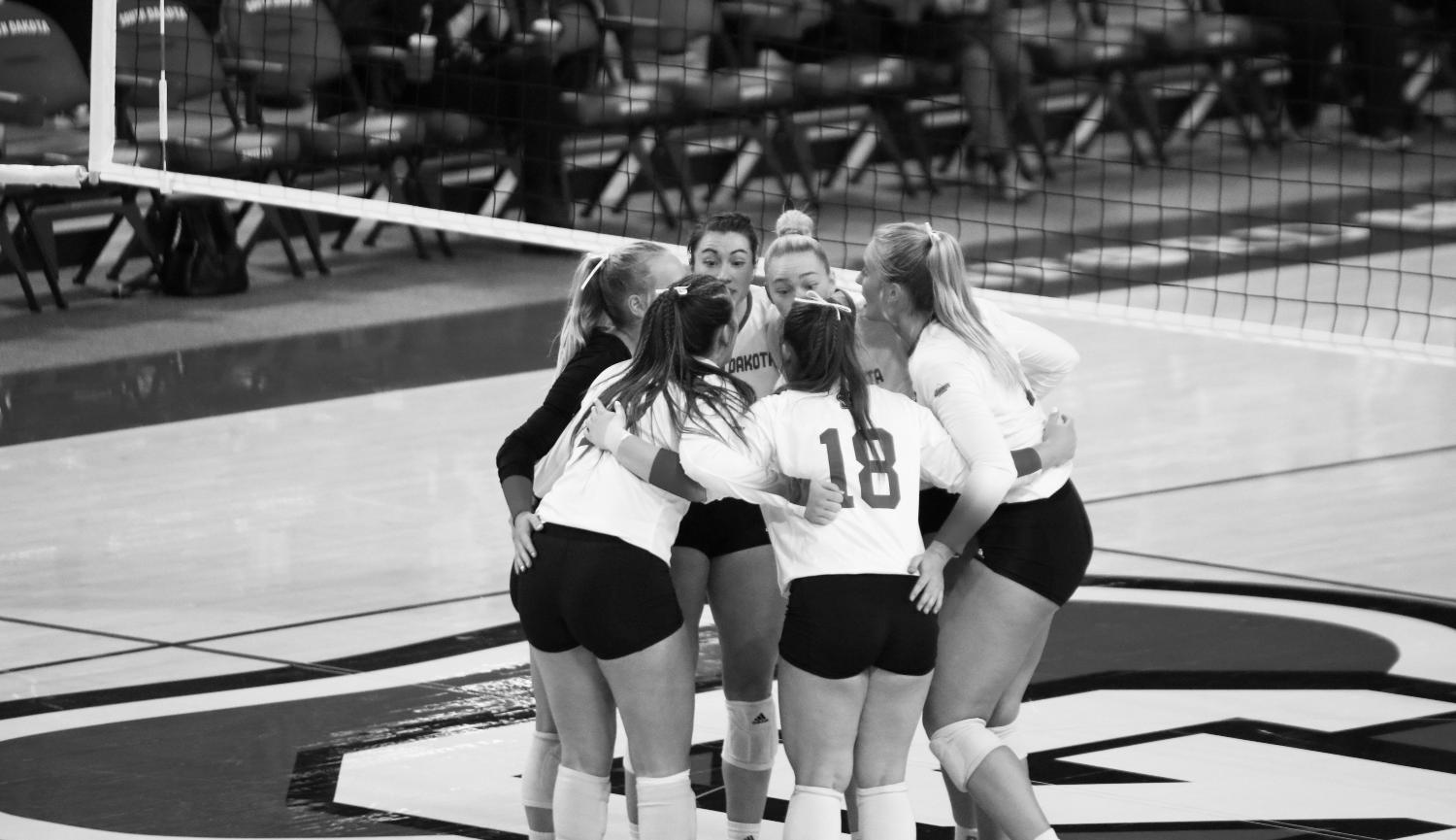
The Summit League Network will not feature football because the Summit League does not have a football conference. Rather, the Coyotes play in the Missouri Valley Football Conference, which is part of the Football Championship Subdivision.
The Summit League Network is available on mobile and tablet apps, including iOS and Android devices. It is also accessible on TV devices such as AppleTV, FireTV and Roku. The service also can be accessed through web browsers at SummitLeagueNetwork.tv.
In addition to live events, the Summit League Network will provide highlights, replays, interviews and special features.
With the introduction of this new streaming service, Coyote fans statewide can now watch games that would not have been accessible before.
There’s a lot to be said for the state of USD’s parking.
One could criticize the size of the parking stalls or the ticketers dispatched in full force, but compared to other universities, USD’s parking is actually in pretty good shape.
Example 1: Take the University of Iowa. Freshmen are encouraged not to bring a vehicle, and if they choose to do so, they are limited to one specific parking lot at the price of around $279/ semester, or $558/year. The Hawkeye’s equivalent for an “A” parking pass is only $121/semester, but one must park over 2 miles away and take a shuttle bus to campus.
Example 2: The University of Nebraska-Lincoln issues their parking fees monthly. They range from $23-to-$88 dollars per month depending on the lot. For
an academic year of ten months, the price runs between $230 and $880. Some of their options include paying for a specific parking stall.
Example 3: South Dakota State University charges their on-campus staff a different rate than they do their students. To reserve a permit for 12 months, it would cost a staff member $365 for a year. The nine month student parking pass costs students 161, while a staff pass costs $297.
Parking at USD acts as the great equalizer. Undergraduate students, gradu-
”
ate students, full-ride scholars and tenured professors all pay $170.
While the cost is still more than insignificant, being able to park on campus as a commuter and walk almost anywhere in 10 or 15 minutes is not the norm for most university campuses.
USD students are lucky to have an accessible campus that isn’t spread across half a city. With the addition of the new parking lot across from the Health Sciences Building, the only reason one wouldn’t be able to find close parking is by arriving
too close to class time.
USD also offers more than one type of parking pass. They offer it as “A”, “B”, “L” and “S” which all can park in various locations located on campus. “A” parking allows you to park in 14 locations on campus (not including the all permit zones). As for “B” passes, those are for students living in dorms and many first year students buy this pass. “L” only has one zone for the Lambda Chi fraternity.
Students at USD have all come to know the incessant barrage of parking tickets for a wide range of reasons. This is, however, a universal occurrence and not unique to USD. As much as the parking tickets are unpleasant, they can usually be avoided with a somewhat competent parking job.
All things considered, parking could be way worse. Just another reason to Go Yotes!
THE STUDENTS’ VOICE SINCE 1887
The Volante welcomes letters to the editor in regards to campus, local, state and national issues. Letters will be edited for clarity and length and will be printed as space allows. Please limit letters to 300 words or fewer. The Volante reserves the right to hold letters for publication in a later issue. Submissions must include the author’s name, address, telephone number, year in school and major or job title. Letters must be exclusively for The Volante. We will not publish anonymous letters.
Send letters to: Al Neuharth Media Center
555 N. Dakota St. Vermillion, S.D. 57069
Fax to: 605.677.5105
Email to: volante@coyotes. usd.edu
Via our website: volanteonline.com
The deadline for letters is 5 p.m. the Friday prior to publication. Letters must be typed and fewer than 300 words.
Here you’ll find the weirdest, funniest and stupidest things we’ve heard during the week. Context is for suckers.
“I feel like everything is just broken”
— Patterson
“I am going to steal your baby and give it back to you three hours later.”
— Neuharth
“I can’t tell if he’s drug dealer or a hockey player.”
— MUC
“I would rather live under a bridge than become actuary.”
— Patterson
USD students are lucky to have an accessible campus that isn’t spread across half a city.
“ The
EDITORIAL BOARD
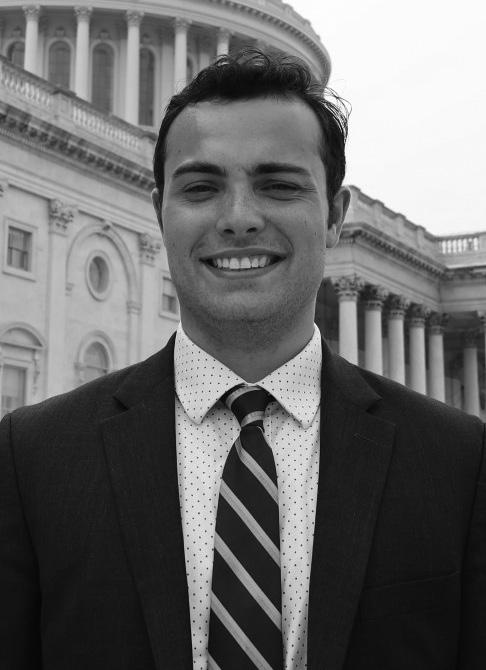
Have you ever spaced out in that English or math class you didn’t want to take and thought to yourself, “why am I taking this course even though I’m a _____ major?”
You’re not alone.
The South Dakota Board of Regents (SDBOR) is the leading culprit behind these requirements. In order to graduate from a South Dakota public university, the SDBOR mandates that you must take 30 credits of general education courses that satisfy six goals relating to Written Communication, Oral Communication, Social Sciences, Arts and Humanities, Mathematics and Natural Sciences. You can see these in DegreeWorks listed as “Gen-Ed Requirements.”
It’s clear the SDBOR intended for gen-eds to make graduates more well-rounded. For example, their Social
Sciences goal states, “Students will understand the organization, potential, and diversity of the human community through study of the social sciences.”
That seems like a noble cause. I’m not suggesting that the SDBOR wrote these goals as a pretext to generate more revenue. In fact, it’s probable the SDBOR had genuine intentions behind the policy. However, the intentions behind forcing students to pay for 30 credit hours of courses not relating to their major does not affect the impact it has on the student body.
In monetary terms, gen-eds cost you somewhere in the ballpark of $9,432 or $12,942, depending on if you are eligible for in-state tuition. That’s a hefty price to pay to become a well-rounded person.
Looking at last year’s graduating class of around 1,280
students, assuming the average student paid $10,000 for gened courses, USD made $12.8 million from general education requirements off of the class of 2023.
I’d rather pay ten grand toward courses I’m interested in than have the SDBOR decide.
These requirements are not universal. The United Kingdom, in-large, does not impose general education requirements on their university students. In fact, a bachelor’s degree usually takes three years to complete, not four. Some ivy-league schools and tech schools, such as Brown or MIT, do not require general education requirements, but in some cases, require students take more courses in their major or more electives.
The most problematic aspect of gen-ed requirements isn’t even the cost. The merits of gen-ed requirements ultimately
In middle school and high school, students all over the country are thrown into language programs and taught the basics like colors, food and ways to say hello. However, as they make their way to college, very few continue on with the language they chose in those lower grade levels.
According to the American Academy of Arts and Sciences, in 2019 only 7.5% of college students were enrolled in a foreign language course.
This is a very unfortunate statistic because those students who chose not to continue their foreign language education are missing out on vital benefits
that language learning can have in the long run.
The process of learning a new language is a balance between understanding new words and grammatical structures while also building on previous knowledge. This process is an effective brain workout and according to Cambridge University it is a workout that can prevent dementia and degenerative neurological conditions later in life.
Advantages that language learning has on students is immense. It includes everything from improved academic performance, better concentration and a more powerful memory
to stronger communication skills and advanced creativity. All of these skills improve the chance for success in the classroom and workforce.
While studying a foreign language can be difficult at times, and the frustration of not knowing how to conjugate the present versus past tense of a verb may cause you to want to pull your hair out, just remember you are actually giving your brain a workout that will better prepare you to succeed in the long run.
Not only does foreign language curriculum contribute to better brain health, it also contributes to a better world. Students who are enrolled in
rest on whether it is the role of a university to make you a more well-rounded person. I argue that it is not: all of us went through at least twelve years of education that should have made us ready for society, independent of our decision to attend university. We have much larger problems if K-12 schools are not accomplishing their most basic function.
It’s easy to forget that we are the customer in this transaction, not the university and certainly not the SDBOR.
It is up to us to decide what we want to get out of our university experience. If you feel that taking a fine arts or natural science course will make you a better or more successful adult, then go for it! But the decision should be yours to make.
What do you really want out of university?

language courses get a better understanding of different cultures both in their communities and around the world. Many of these students also choose to study abroad which helps to expand on this cultural understanding of what they’re learning in the classroom.
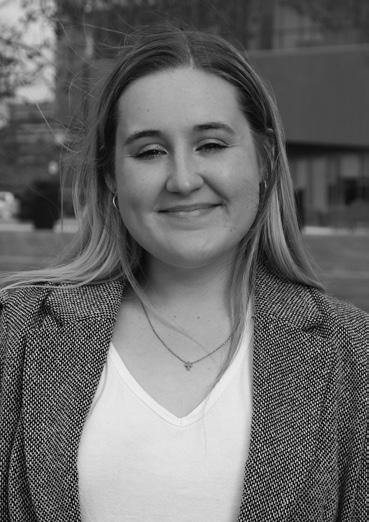
This ability to comprehend different cultures allows us to be better educated, informed and empathetic about those living around us.
I believe all students should be taking advantage of the skills and benefits that language learning can have on brain health as well as the overall health of our communities.

that my husband and I write a check to help sponsor the gallery.”
On Aug. 28, the National Music Museum reopened its doors to reveal seven new galleries on their first floor. Scott Lawrence, Chair of the Board of Trustees, has been a part of the process since it began.
“We are so excited about this event,” Lawrence said. “It’s seven years in the making, and there’s been a lot of folks that’ve stepped up, such as the state, partners from before, exhibitions and our board. The staff has done a remarkable job at getting ready for today. We are so excited about it. It’s been a long road, but you know, we’re here.”
The major donors of these galleries consist of the state of South Dakota, Patricia J. Knutson estate, the University of South Dakota, the National Music Museum Board of Trustees and plenty of others in the community. De Knudson, who served on the National Music Museum board in the past, is a donor who has one of the galleries named after her.
“My husband and I made a gift to the National Music Museum because I knew that it was time to get these seven galleries done,” Knudson said. “We had been talking about this for quite a few years. I had stepped aside as a board member, but I just thought that it was really important
Michael Suing, deputy director of collections at the National Music Museum, worked with AJ Goehle, CEO of Luci Creative. Together, they worked with their teams to plan, design and create these new exhibitions.
“For us, the opportunity to work with Michael [Suing] and his team has been unbelievable,” Goehle said. “To work with a team that is so passionate about the stories to tell, the amazing collection that’s here, but most importantly, creating a space that’s welcoming, inviting and exciting for the visitors. There is no better gift than being able to walk away and saying that we did it. Now there’s this gem here for people to come visit and experience something that they haven’t in a new way.”
This set of new galleries completes phase one of the museum’s permanent exhibitions. Phase two is currently being planned with the National Music Museum’s Board of Trustees.
“The best possible plan is that phase two, all of the second floor galleries, could be open about this time next year,” Director of the National Music Museum Dwight Vaught said. “We’re still trying to figure all of that out.”
Overall, the museum’s goal has been to design and reimagine the way that they told their stories. They now have the chance to share that with the Vermillion community what they have been working on for years.
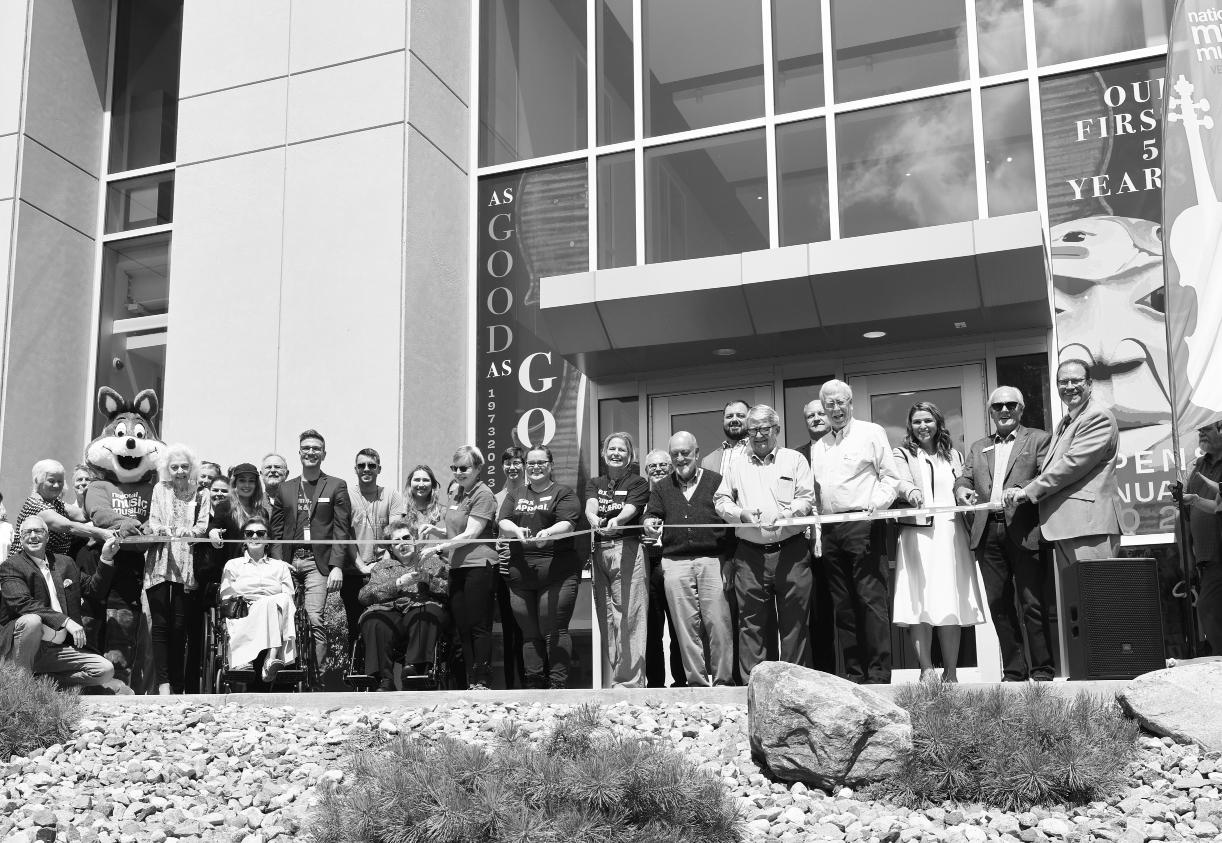
“What I want [is for] anybody that comes to the National Music Museum to leave with is that music is theirs,” Suing said. “This place, the stories that are here, they are ours to share. The story of people and music around the world is universal.”
“If they knew about us in the previous version of the museum, forget about that,” Vaught said. “This is completely different. It’s sort of a bold reframing of everything and we just want them to come in, check it out and be inspired.”
The National Music Museum is open Wednesdays through Fridays from 10 a.m. to 4 p.m. and Saturdays from noon to 4 p.m. For more information, you can visit their website https://www.nmmusd.org/.
 Maddie Martinez | The Volante The National Music Museum held a ribbon cutting ceremony before inviting the community in to view the seven new exhibits.
Sydney Kolln Sydney.Kolln@coyotes.usd.edu
Maddie Martinez | The Volante (Far left): A group of onlookers take part in the museum’s opening day for their new galleries. Many of these galleries were created with help from donors including the University of South Dakota.
(Near left): A community member admires one of the new galleries opened by the National Music Museum. These new galleries are phase one of the museum’s permanent exhibitions.
Maddie Martinez | The Volante The National Music Museum held a ribbon cutting ceremony before inviting the community in to view the seven new exhibits.
Sydney Kolln Sydney.Kolln@coyotes.usd.edu
Maddie Martinez | The Volante (Far left): A group of onlookers take part in the museum’s opening day for their new galleries. Many of these galleries were created with help from donors including the University of South Dakota.
(Near left): A community member admires one of the new galleries opened by the National Music Museum. These new galleries are phase one of the museum’s permanent exhibitions.
Many USD students are familiar with the on-campus library, but few are aware of the vast resources that the Vermillion Public Library has. The Edith B. Siegrist Vermillion Public Library was established in 1902 with funds from Andrew Carnegie.
Edith B. Siegrist, whom the building is named after, worked at the University of South Dakota as an instructor in the Librarian Science program and as a librarian in the old Carnegie Library. In 1982, she became a full-time librarian for the I.D. Weeks Library at USD. She was even named South Dakota Librarian of the Year in 1985.
Siegrist lived in Vermillion until she passed away in 2011. Her main goal was to make sure that everyone in the Vermillion area who loved books as much as she did would have access to it through the expansion of the Vermillion Public Library.
Today, Siegrist’s memory is still alive and thriving at the Vermillion Public Library. Now, more than ever, the library is for everyone of all ages.
Children have the chance to be a part of the Little Learners, which is a storytime for three to five year olds. For kids in kindergarten to fifth grade, they have the chance to be part of the LEGO club or go to the Movie ‘n Popcorn night. Sixth-to-twelfth graders are also able to be part of the Teen Takeover or Open Game Time.
University of South Dakota students can also get in on the action happening at the library. USD students can receive their Vermillion Public Library card free of charge by asking a librarian. With this card, students get to have a quiet study space, fast Wi-Fi, free coffee and many other benefits.
Regardless of whatever age someone may be, the Vermillion Public Library is a place for everyone. Whether you attend one of their events or even just check out a book, the library is there for you and the community.

To learn more about the Vermillion Public Library, visit their website at https:// vermillionpubliclibrary.org/.
atomic bomb while questioning the morality and the consequences the bomb would have on the world.
nity to celebrate something and make an event out of the premier.
Throughout the past few years, cinemas have been dominated by franchise movies that often follow the same plot with different characters. This summer, “Barbie” and “Oppenheimer” were able to captivate audiences with their strong stories and fresh perspectives.
“Barbie’’ follows the story of Barbie as she faces an existential crisis that causes her to further question the life that she was living. Despite this serious plot, the movie features bright colors, pop tunes and comedic relief through the Kens.
“I thought ‘Barbie’ had such a wonderfully fresh tone to it overall,” Rai Genna, the Chair of the USD Theatre Department, said. “It was very clever in terms of conveying the messages that it wanted to convey without hitting you over the head.”
“Oppenheimer,” on the other hand, followed J. Robert Oppenheimer as he worked on the development of the
“‘Oppenheimer’ is totally different in terms of tone, but again, it was really different from what has been out there for a while,” Genna said. “I thought it wasn’t perfect, but I thought it was a really strong film. Oddly enough, it didn’t feel like three hours.”
These two movies, while vastly different in tone, were able to distance themselves from the superhero-like movies that had been the norm.
“I do think that we had a very lackluster summer in terms of movies,” Genna said. “The movies that we had had prior to that were just rehashes of what we had seen before, and the idea that we had, coming out on the same day, ‘I have become death, destroyer of worlds’ – this really dark, foreboding thing, and then we have ‘Barbie.’ I was really happy that the whole purpose wasn’t ‘Hey, this is a franchise.’”
Furthermore, these movies offered viewers the opportu-
“It resembled ‘Star Wars’ in that people dressed up to go see the movie, so there was a level of cosplay that went beyond just people who grew up playing with Barbie,” Genna said. “There is so much happening in the world, I think that people wanted to celebrate something. They wanted to have an event.”
For many, “Barbie” and “Oppenheimer” were seen as a double feature, in which viewers saw both movies in the same day. Additionally, many viewers also referred to the simultaneous release of both as “Barbenheimer,” a term that the public came up with, rather than the studio.
“It was that fan creation that made it sound like ‘Hey, movies are back’… I think it demonstrated that, in terms of cultural significance, that at least in this historical moment, people want to see interesting stories,” Genna said.